Dates 26 Mar 1885 – 12 May 1885 | ||
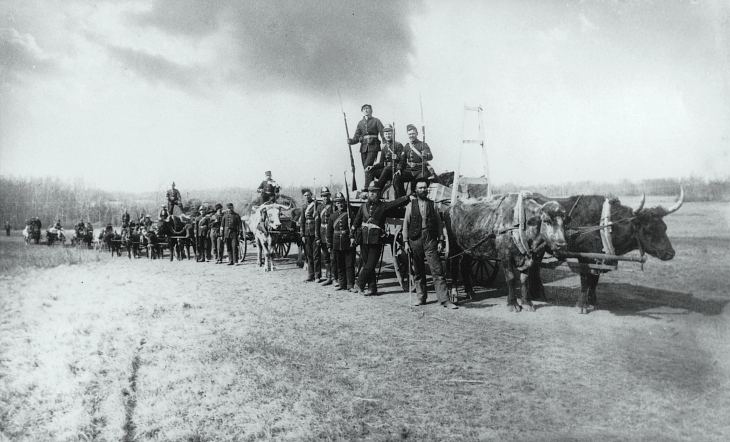 | ||
38 dead141 wounded11 civilians killed 33 Métis dead48 Métis wounded10–17 Cree dead78–103 Cree woundedTotal (Military)43–50 dead126–151 wounded Similar | ||
The North-West Rebellion (or the North-West Resistance, Saskatchewan Rebellion, Northwest Uprising, or Second Riel Rebellion) of 1885 was a brief and unsuccessful uprising by the Métis people under Louis Riel and an associated uprising by First Nations Cree and Assiniboine of the District of Saskatchewan against the government of Canada. The Métis believed that Canada had failed to protect their rights, their land and their survival as a distinct people. Riel had been invited to lead the movement but he turned it into a military action with a heavily religious tone, thereby alienating the Catholic clergy, the whites, most of the Indians and some of the Métis. He had a force of a couple hundred Métis and a smaller number of Aboriginal at Batoche in May 1885, confronting 900 government troops.
Contents
- Background
- Demographics
- Conflicts
- Battle of Duck Lake
- The Government Reacts
- Looting of Battleford
- Frog Lake Massacre
- Battle of Fort Pitt
- Battle of Fish Creek
- Battle of Cut Knife
- Battle of Batoche
- Battle of Frenchmans Butte
- Battle of Loon Lake
- International attention
- Aftermath
- Legacy
- Memorials
- In fiction
- References
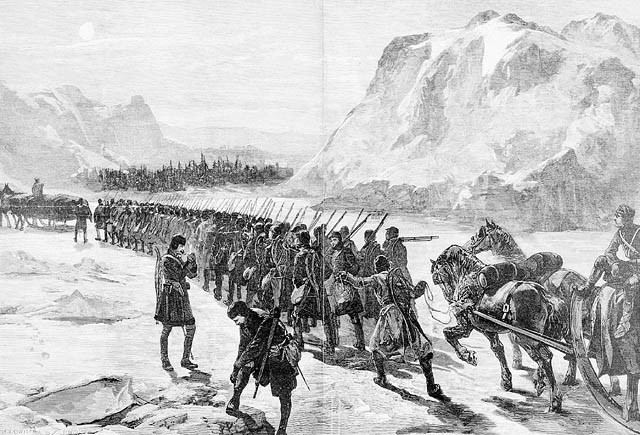
Despite some notable early victories at Duck Lake, Fish Creek and Cut Knife, the rebellion ended when the Métis were defeated at the siege of Batoche. The remaining Aboriginal allies scattered. Riel was captured and put on trial. He was convicted of treason and despite many pleas across Canada for amnesty, he was hanged. Riel became the heroic martyr to Francophone Canada and ethnic tensions escalated into a major national division that was never resolved. Thanks to the key role that the Canadian Pacific Railway played in transporting troops, Conservative political support for it increased and Parliament authorized funds to complete the country's first transcontinental railway. Although only a few hundred people were directly affected in Saskatchewan, the long-term result was that the Prairie Provinces would be controlled by English speakers, not the French Canadians. A much more important long-term impact was the bitter alienation French speakers across Canada showed, and anger against the repression of their countrymen.
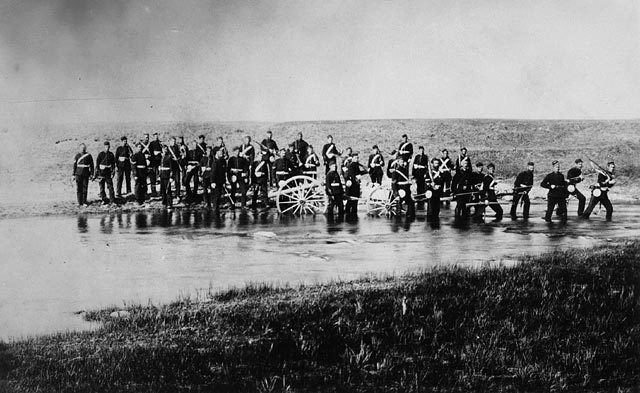
Background
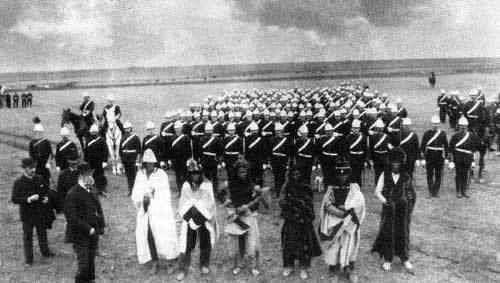
After the Red River Rebellion of 1869–1870, many of the Métis moved from Manitoba to the Fort Carlton region of the Northwest Territories, where they founded the Southbranch settlements of Fish Creek, Batoche, St. Laurent, St. Louis, and Duck Lake on or near the South Saskatchewan River. In 1882, surveyors began dividing the land of the newly formed District of Saskatchewan in the square concession system. The Métis lands were laid out in the seigneurial system of strips reaching back from a river which the Métis were familiar with in their French-Canadian culture. A year after the survey the 36 families of the parish of St. Louis found that their land and village site that included a church and a school (in Tsp 45 Rge 7 W2 of the Dominion Land Survey) had been sold by the Government of Canada to the Prince Albert Colonization Company. Not having clear title the Métis feared losing their land which, now that the buffalo herds were gone, was their primary source of sustenance.
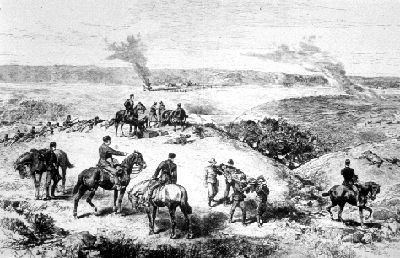
In 1884, the Métis (including the Anglo-Métis) asked Louis Riel to return from the United States, where he had fled after the Red River Rebellion, to appeal to the government on their behalf. The government gave a vague response. In March 1885, Riel, Gabriel Dumont, Honoré Jackson (a.k.a. Will Jackson), and others set up the Provisional Government of Saskatchewan, believing that they could influence the federal government in the same way as they had in 1869.
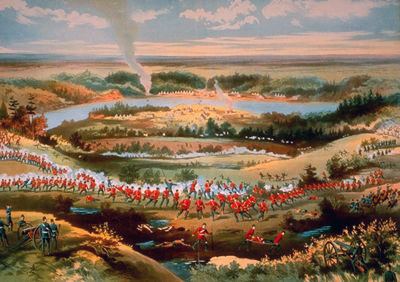
The role of aboriginal peoples prior to—and during—the outbreak of the rebellion is often misunderstood. A number of factors have created the misconception that the Cree and Métis were acting in unison. By the end of the 1870s, the stage was set for discontent among the aboriginal people of the prairies: the bison population was in serious decline (creating enormous economic difficulties) and, in an attempt to assert control over aboriginal settlement, the federal government often violated the terms of the treaties it had signed during the latter part of the decade. Thus, widespread dissatisfaction with the treaties and rampant poverty spurred Big Bear, a Cree chief, to embark on a diplomatic campaign to renegotiate the terms of the treaties (the timing of this campaign happened to coincide with an increased sense of frustration among the Métis). When the Cree initiated violence in the spring of 1885, it was almost certainly unrelated to the revolt of Riel and the Métis (which was already underway). In both the Frog Lake Massacre and the Siege of Fort Battleford, small dissident groups of Cree men revolted against the authority of Big Bear and Poundmaker. Although he quietly signalled to Ottawa that these two incidents were the result of desperate and starving people and were, as such, unrelated to the rebellion, Edgar Dewdney, the lieutenant-governor of the territories, publicly claimed that the Cree and the Métis had joined forces.
For Riel and the Métis, several factors had changed since the Red River Rebellion. The railway had been completed across the prairies in 1883, though sections were still under construction north of Lake Superior, making it easier for the government to get troops into the area. In addition, the North-West Mounted Police (NWMP) had been created, developing an armed local force. Riel lacked support from English settlers of the area as well as the great majority of tribes. Riel's claim that God had sent him back to Canada as a prophet caused Catholic officials (who saw it as heresy) to try to minimize his support. The Catholic priest, Albert Lacombe, worked to obtain assurances from Crowfoot that his Blackfoot warriors would not participate in a rebellion.
Demographics
The District of Saskatchewan, part of the Northwest Territories in 1885, was divided into three sub-districts and had a population of 10,595. To the east, the Carrot River sub-district with 1,770 people remained quiet. The Prince Albert sub-district located in the centre of the district had a population of 5,373 which included the Southbranch settlements with about 1,300. The Southbranch settlement was the centre of Louis Riel's Provisional Government of Saskatchewan during the Rebellion. To the west, where the Cree uprising led by Poundmaker and Big Bear occurred, was the Battleford sub-district with 3,603 people.
The largest settlement and the capital of the district was Prince Albert with about 800 people followed by Battleford with about 500 people who were "divided about equally between French, Métis and English".
The Métis population in Saskatchewan in 1885 was about 5,400. A majority tried to stay neutral in the dispute with the national government, as the priests recommended. About 350 armed men supported Riel. A smaller number opposed him, led by Charles Nolin. in addition he had the support of a small number of the Indians. Riel's supporters included the older, less assimilated Métis, often with close associations with the Indian population. Many moved back and forth into Indian communities and preferred to speak Indian languages more than French. Riel's opponents were younger, better educated Métis; they wanted to be more integrated into Canadian society, not to set up a separate domain as Riel promised.
Conflicts
Riel had been invited in to lead the movement but he turned it into a military action with a heavily religious tone, thereby alienating the Catholic clergy, the whites, nearly all of the First Nations, and most of the Métis. He had a force of a couple hundred Métis and a smaller number of First Nations at Batoche in May 1885, confronting 900 government troops.
Battle of Duck Lake
On March 26, 1885, the 150 to 200 Métis and Aboriginal warriors under the command of Gabriel Dumont defeated a combined group of 90 Prince Albert Volunteers and North-West Mounted Police led by their superintendent Leif Newry Fitzroy Crozier at Duck Lake, outside Batoche.
The federal government had, shortly before the battle at Duck Lake, sent Major General Frederick Middleton to the West. Eventually, over a period of many weeks, Middleton brought 3,000 troops to the West, and incorporated another 2,000, mostly English-Canadian volunteers, and 500 North-West Mounted Police into his force.
The Government Reacts
Recognizing that an uprising might be imminent, the federal government had, three days before Duck Lake, sent Major General Frederick Middleton, the commander of the Canadian militia, to Winnipeg, where a unit of militia, the 90th Winnipeg Rifles, and of militia artillery, the Winnipeg Field Battery, already existed. After Duck Lake, the government immediately commenced the mobilization of Canada's many amateurishly-led, badly-trained and ill-equipped militia units, as well as the tiny forces of infantry and artillery regulars who made up the almost-nonexistent regular Canadian Army. By March 30, after hasty mobilization in Toronto, two trains containing the 10th Royal Grenadiers and Queen's Own Rifles militia regiments were ready to leave Toronto. Other militia units, the 9th Voltigeurs from Quebec City, and the 65th Mount Royal Rifles from Montreal, were also quickly mobilized. Soon every major city in the East was the scene of embarkation for inexperienced young militiamen cheered by immense crowds. The first militia to struggle westward had to contend with the many lengthy breaks in the C.P.R. railway line in northern Ontario. They marched through snow, or were carried in exposed sleighs. Where there were short stretches of track, the militia rode on hastily-constructed railroad flatcars which did nothing to shelter them from the extreme cold. Many of the soldiers suffered greatly from the winter weather. However, the first troops sent West were, in succeeding weeks, followed by thousands more.
Looting of Battleford
On March 30, 1885, a raiding party of Cree people, short of food due to declining bison populations, approached Battleford. The inhabitants fled to the nearby North-West Mounted Police post, Fort Battleford. The Cree then took food and supplies from the empty stores and houses. As well, Cree insurgents looted Hudson's Bay Company posts at Lac la Biche and Green Lake on April 26.
Frog Lake Massacre
On April 2, 1885, near Frog Lake, Saskatchewan (now in Alberta) a Cree raiding party led by Wandering Spirit attacked a small town. Angered by what seemed to be unfair treaties and the withholding of vital provisions by the Canadian government, and also by the dwindling buffalo population, their main source of food, Big Bear and his Cree decided to rebel after the successful Métis victory at Duck Lake. They gathered all the white settlers in the area into the local church. They killed Thomas Quinn, the town's Indian Agent, after a disagreement broke out. The Cree then attacked the settlers, killing eight more and taking three captive.
The massacre prompted the Canadian government to take notice of the growing unrest in the North-West Territories. When the rebellion was put down, the government hanged Wandering Spirit, the war chief responsible for the Frog Lake Massacre.
Battle of Fort Pitt
On April 15, 1885, 200 Cree warriors descended on Fort Pitt. They intercepted a police scouting party, killing a constable, wounding another, and captured a third. Surrounded and outnumbered, garrison commander Francis Dickens capitulated and agreed to negotiate with the attackers. Big Bear released the remaining police officers but kept the townspeople as hostages and destroyed the fort. Six days later, Inspector Dickens and his men reached safety at Battleford.
Battle of Fish Creek
On April 24, 1885, at Fish Creek, Saskatchewan, 200 Métis achieved a remarkable victory over a superior government force numbering 900 soldiers who were sent to quell the rebellion. The reversal, though not decisive enough to alter the outcome of the war, temporarily halted Major General Frederick Middleton's column's advance on Batoche. That was where the Métis would later make their final stand.
Battle of Cut Knife
On May 2, 1885, the Cree war chief Fine-Day defeated Lieutenant Colonel William Otter at the Battle of Cut Knife near Battleford. Despite their use of a Gatling gun, a flying column of Canadian militia and army regulars, government forces were defeated. Fine-Day was affiliated with the chief Poundmaker. Big Bear would not get involved.
Battle of Batoche
On May 9, 1885, Middleton attacked Batoche itself. The greatly outnumbered Métis ran out of ammunition after three days of battle and siege. The Métis resorted to firing sharp objects and small rocks from their guns, until they were killed or dispersed when Middleton's soldiers advanced in strength and overran their rifle pits. Riel surrendered on May 15. Gabriel Dumont and other participants escaped across the border to the Montana Territory of the United States.
Battle of Frenchman's Butte
On May 28, 1885, Major General Thomas Bland Strange brought an NWMP detachment from Calgary, Alberta, but they were unable to defeat a Cree force under Big Bear who carried the day at Frenchman's Butte at the end of May.
Battle of Loon Lake
On June 3, 1885, a small detachment of North-West Mounted Police under the command of Major Sam Steele caught up to a band of Cree led by Big Bear who were moving northward after their victory at Frenchman's Butte. The Cree were almost out of ammunition, and were forced to flee after a short exchange of fire and the release of their hostages.
International attention
While the North-West Rebellion was ongoing, the American and British press took note of the actions of both the Métis and the Canadian Government. Different newspapers, such as the British Times and Guardian wrote approvingly of the actions taken by the Canadian government and by extension, the British Empire against what was seen as another 'native' uprising.
Aftermath
Demoralized, defenceless, and with no hope of relief after the surrender of the Métis and Poundmaker, most of the Cree surrendered over the next few weeks. On July 2 Big Bear surrendered to the NWMP on an island in the Saskatchewan River near Fort Carlton. The government pacified the Cree and Assiniboine by sending them food and other supplies. Poundmaker and Big Bear were sentenced to prison. Eight other Aboriginal leaders were hanged in the largest mass hanging in Canadian history. Riel was tried and hanged as well, sparking a national controversy between French and British Canada.
The Canadian Pacific Railway (CPR) played a key role in the government's response to the Rebellion, as it was able to transport federal troops to the area quickly. While it had taken three months to get troops to the Red River Rebellion, the government was able to move forces in nine days by train in response to events in the North-West Territories. The successful operation increased political support for the floundering and incomplete railway, which had been close to financial collapse. The government authorized enough funds to finish the line. Thus, Prime Minister John A. Macdonald was able to realize his National Dream of linking Canada across the continent.
In what is now Saskatchewan, shortly after the fighting, the first modern-style election took place in the North-West Territories election of 1885. The Scrip Commission was dispatched to the District of Saskatchewan to address the issue of Métis land claims.
The Rebellion was Canada's first independent military action. It cost about $5 million, and lost the Conservative Party most of their support in Quebec. It guaranteed Anglophone control of the Prairies, and demonstrated the national government was capable of decisive action.
Legacy
The Saskatchewan Métis' requested land grants; they were all provided by the government by the end of 1887, and the government resurveyed the Métis river lots in accordance with their wishes. The Métis did not understand the long term value of their new land, however, and sold much of it to speculators who later resold it to farmers. The French language and Catholic religion faced increasing marginalisation in both Saskatchewan and Manitoba, as exemplified by the emerging controversy surrounding the Manitoba Schools Question. The Métis themselves were increasingly forced to live on undesirable land or in the shadow of Indian reserves (as they did not themselves have treaty status as Indians with a right to land).
Riel's trial and Macdonald's refusal to commute his sentence caused lasting upset in Quebec, and led to a fundamental francophone distrust of Anglophone politicians. French Canada felt it had been unfairly targeted.
Memorials
In the spring of 2008, Tourism, Parks, Culture and Sport Minister Christine Tell proclaimed in Duck Lake, that "the 125th commemoration, in 2010, of the 1885 Northwest Rebellion is an excellent opportunity to tell the story of the prairie Métis and First Nations peoples' struggle with Government forces and how it has shaped Canada today."
Batoche, where a Métis Provisional Government had been formed, has been declared a National Historic Site. Batoche marks the site of Gabriel Dumont's grave site, Albert Caron’s House, Batoche school, Batoche cemetery, Letendre store, Dumont's river crossing, Gariépy's crossing, Batoche crossing, St. Antoine de Padoue Church, Métis rifle pits, and RNWMP battle camp.
Fort Carlton Provincial Historic site has been rebuilt as it had been ravaged by three separate fires. Big Bear (Mistahimaskwa) had used the site in his initial negotiations for Treaty Six in about 1884, and finally, the following year he surrendered here after his engagement at Steele Narrows. The Prince Albert blockhouse was employed by the North-West Mounted Police on evacuating from Fort Carlton after the first fire. Duck Lake is home to the Duck Lake Historical Museum and the Duck Lake Regional Interpretive Centre, and murals which reflect the history of the Rebellion in the area. The Battle of Duck Lake, the Duck Lake Massacre, and a buffalo jump are all located here. The "First Shots Cairn" was erected on Saskatchewan Highway 212 as a landmark commemorating the scene of the first shots in the Battle of Duck Lake. The Our Lady of Lourdes Shrine at St. Laurent north of Duck Lake is a local pilgrimage site. The Battle of Fish Creek National Historic Site, the name has been changed to Tourond's Coulee / Fish Creek National Historic Site to preserve the battlefield of April 24, 1885, at la coulée des Tourond , Madame Tourond’s home, early Red River cart Fish Creek Trail and the site of Middleton’s camp and graveyard.
The Marr Residence is a municipal heritage property of Saskatoon which served as a field hospital for wounded soldiers of the rebellion. Fort Otter was constructed at Battleford's government house located at the capital of the North-West Territories. Poundmaker was arrested at Fort Battleford and sentenced to a prison term. Eight First Nations men were hanged, five due to participation in the Frog Lake Massacre, two for murders in the Battleford area, and one for the killing of a Mountie at Fort Pitt on April 15. Fort Battleford has been declared a National Historic site of Canada to commemorate its role as military base of operations for Cut Knife Hill, Fort Pitt, as a refuge for 500 area settlers and its role in the Siege of Battleford. Fort Pitt, the scene of the Battle of Fort Pitt, is a Provincial Park and National Historic site where a National Historic Sites and Monuments plaque designates where Treaty Six was signed. Frog Lake Massacre National Historic Site of Canada, at Frog Lake, Alberta, is the location of a Cree uprising that occurred in the District of Saskatchewan North-west Territories. Frenchman Butte is a National Historic Site of Canada. It is the location of a 1885 battle between Cree and Canadian troops.
At Cutknife is the world's largest tomahawk, the Poundmaker Historical Centre and Big Bear monument erected by cairn erected by the Historic Sites and Monuments Board of Canada. There is also now, correctly located, a cairn erected upon Cut Knife Hill the look site of the Poundmaker Battle site and Battle River valley. The Narrows between Makwa Lake and
Sanderson Bay, in the Makwa Lake Provincial Park, was the site of the last engagement of the rebellion. Steele Narrows Provincial Historic Park conserves the lookout point of a Cree burial ground. The Royal Canadian Mounted Police training depot at Regina was established in 1874, and still survives. The RCMP chapel, a frame building built in 1885, is still standing. It was used to jail Indian prisoners. One of three Territorial Government Buildings remains on Dewdney Avenue in the provincial capital city of Regina which was the site of the Trial of Louis Riel, where the drama the Trial of Louis Riel is still performed. Following the May trial, Louis Riel was hanged November 16, 1885. The RCMP Heritage Centre, in Regina, opened in May 2007. The Métis brought his body to Saint-Vital, his mother's home, now the Riel House National Historic Site, and then interred it at the Saint-Boniface Basilica in Manitoba, his birthplace, for burial. Highway 11, stretching from Regina to just south of Prince Albert, has been named Louis Riel Trail by the province; the roadway passes near locations of the 1885 rebellion.
